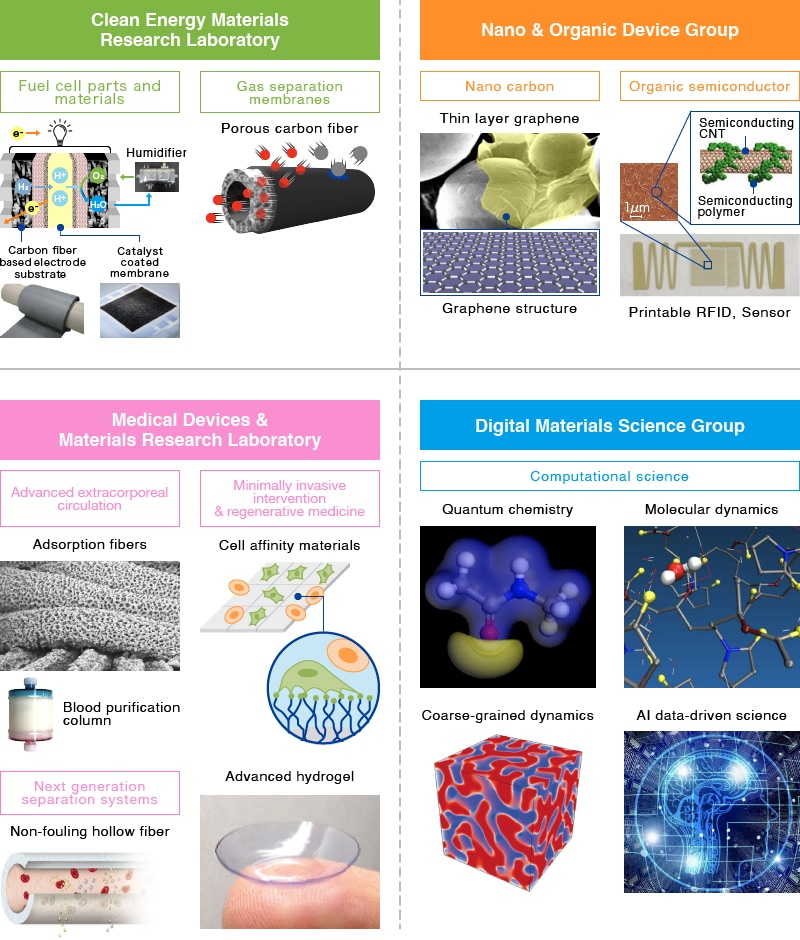- HOME
- Research and Development
- R&D Organization
- Research Laboratories
- Advanced Materials Research Laboratories
Advanced Materials Research Laboratories
The Advanced Materials Research Laboratories carries on the legacy of the Central Research Laboratories, which aimed to create innovative products, and was established in June 2010 to strengthen basic research capabilities and continuously create innovative advanced materials.
Our Advanced Materials Research Laboratories belongs to our Basic Research Center, the basic research department of Toray's Research & Development Division. In order to advance basic research in the materials field based on a uniform company-wide strategy, we have established “Clean Energy Materials Research Laboratory”, “Medical Devices and Material Research Laboratory”, “Nano & Organic Device group”, as well as “Digital Materials Science Group” which promotes digital transformation in materials innovation. We strive to integrate and develop technologies in close collaboration with Toray R&D facilities inside and outside Japan and are focusing in particular on creating state-of-the-art materials by working as a team with Toray Advanced Materials Research Laboratories (China) Co., Ltd. (TARC). While working to strengthen basic research capabilities for Toray's core technology of polymer chemistry, we are conducting basic research on next-generation advanced materials and systems to lead paradigm shifts in society in areas regarded as important by our company, such as the Sustainability Innovation Business and Digital Innovation Business.
At the same time, we are promoting basic materials research to create innovative core materials. More specifically, we are working to create innovative advanced materials and systems such as innovative battery materials and other new energy materials, and advanced medical materials and systems such as extracorporeal circulation columns, and innovative organic devices such as printable RFIDs. Furthermore, we are promoting solutions based on Toray products and technologies for problems such as protecting the global environment, resource/energy issues, and the declining birthrate and aging population, which are key constraints on economic growth.
We will continue to promote basic research in areas such as control of the higher-order structure of polymers, nano-carbon materials, and innovation in materials science with computer simulation and informatics technologies based on computational/information science, which will form the foundation for creating Toray's advanced materials going forward. In addition, to promote these efforts, we are strengthening our open innovation structure, building global cooperation with our partners that straddles the boundaries of industry, government, and academia.

Milestones in Toray R&D
| 1956 | Established Central Research Laboratories. |
|---|---|
| 2010 | Began Advanced Materials Research Laboratories with global system organically integrating basic research functions of three bases in Japan and two bases overseas. |
| 2011 | Started sales of TORAYLIGHT™ NV, a polysulphone membrane artificial kidney with improved ability to inhibit platelet adhesion. |
| 2012 | Established basis for functional membrane design based on free-energy calculation and solution-diffusion (collaboration with the K Computer Strategic Program). |
| 2015 | Developed surface modification technology for dramatically suppressing protein adhesion in blood. Created a hydrocarbon-based electrolyte membrane and electrode substrate technology for hydrogen fuel cells. |
| 2017 | Developed an organic photovoltaic device panel for indoor sensors, exhibiting a maximum of about twice the power generation of conventional devices in low-light environments. |
| 2018 | Created a novel blood purification fiber adsorbent for simultaneous removal of proteins and cells. |
| 2019 | Created world’s first porous carbon fiber with continuous pore structure. Created a novel biodegradable polymer with elasticity and toughness. |
| 2021 | Created ultra-thin graphene dispersion solution offering outstanding fluidity and conductivity. Received the CSJ Award for Young Chemists in Technical Development for "Development of prediction method for interfacial free energy of fluoropolymers using molecular simulations”. Received the JCIA Technology Award for “Developing and commercializing antithrombogenic artificial kidney”. |
